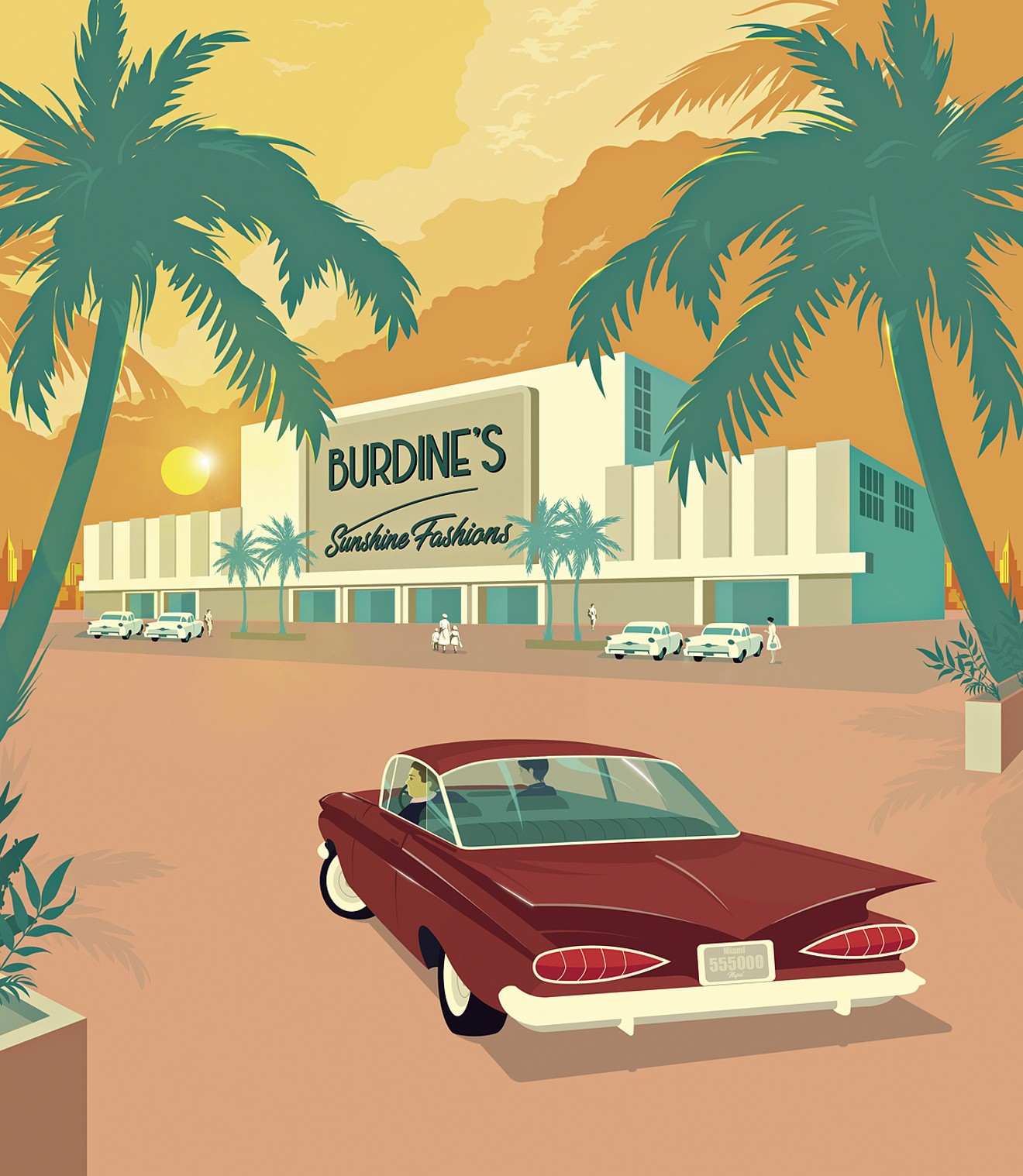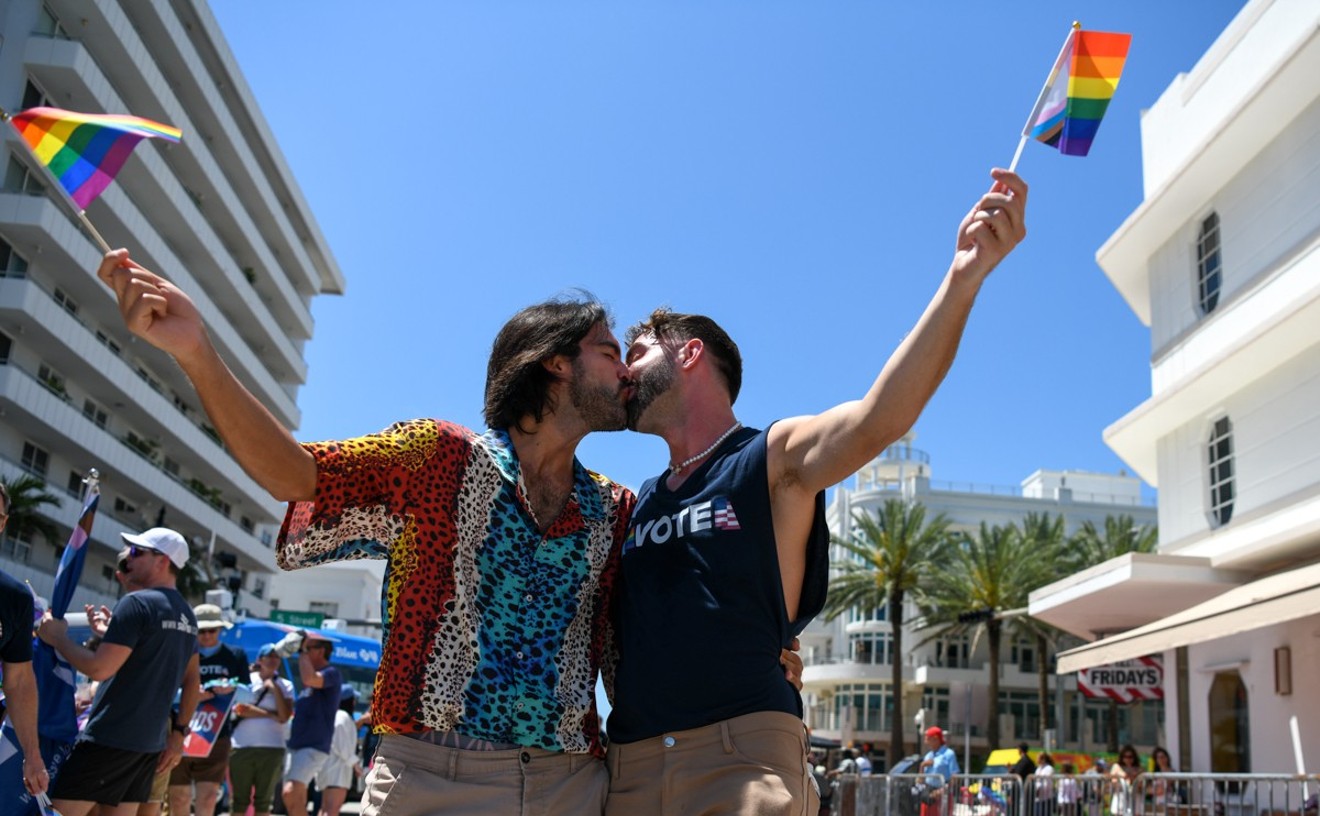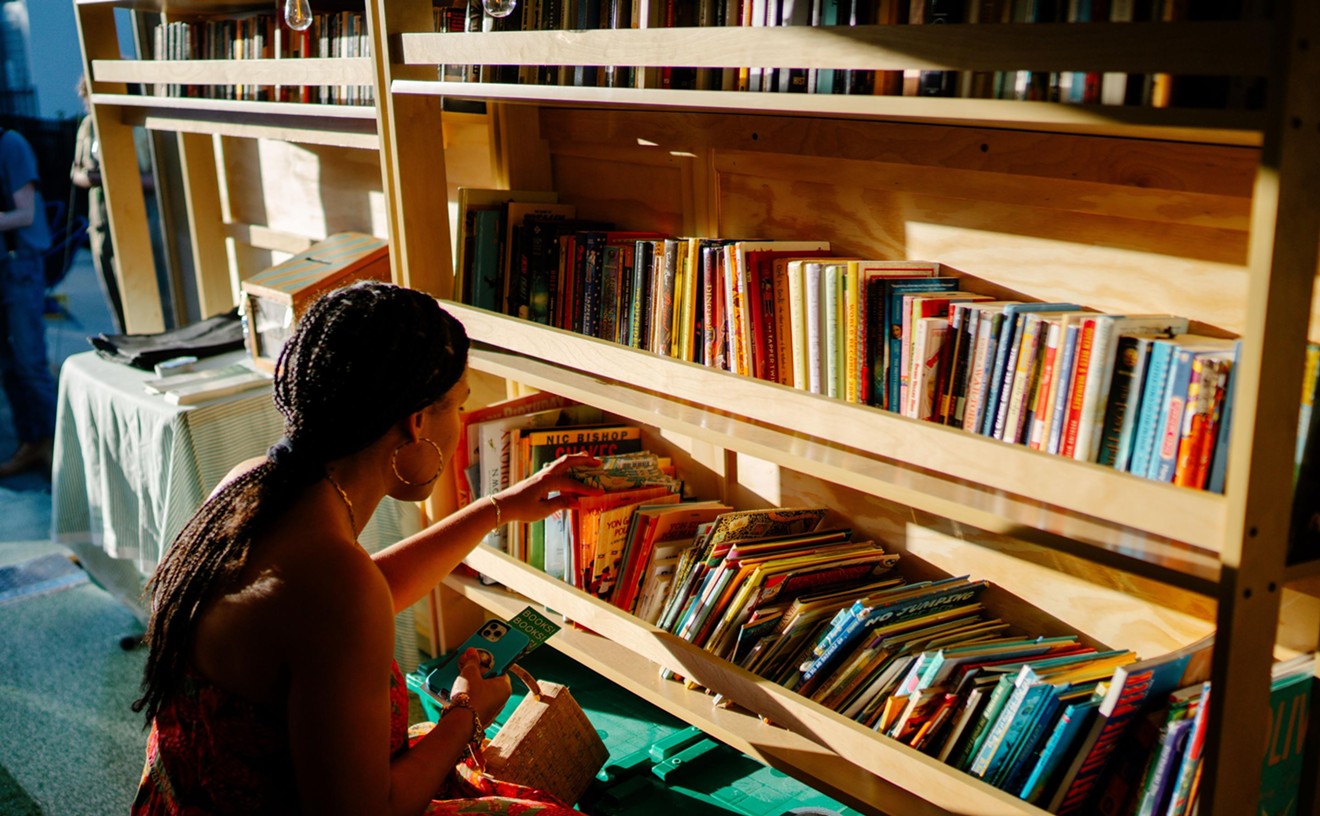Until the mid-'50s, Miami's definitive shopping district was nestled on bustling Flagler Street in downtown. Many amenities standard in today's shopping malls could be found there: department stores (most important, the Burdines on South Miami Avenue), restaurants, general retail, and movie theaters. The area was a place to eat, drink, exchange ideas, watch movies, and, of course, buy things. But as the '50s came to an end, so did downtown Miami's commercial importance. It waned as suburbia was born. Centrally located businesses began to shutter and "For Rent" signs multiplied as entrepreneurs and consumers chased the American dream to the sprawling suburbia out west and down south.
After World War II and the conflict in Korea came an era of international peace and national prosperity. Between 1945 and 1960, the gross national product grew from $200 billion to more than $500 billion. The middle class had more money to spend than ever before, and the widespread use of the automobile allowed fast and convenient travel; living close to one's job was no longer a necessity.
Many of the hundreds of thousands of troops that had been stationed in Miami during the war had, as the old phrase goes, "gotten sand in their boots," and decided to stick around. The city's population boomed, and developers began to see opportunity in the largely undeveloped tracts of land outside the city. They built thousands of modest, inexpensive homes for returning World War II veterans in places such as Kendall and North Dade, which became population centers.
As residential geography shifted, so too did retail and financial centers. Commercial developers reimagined consumer culture while accelerating profit by stoking an economy built on mass consumption. It was in this newly suburbanized and hypercapitalistic environment of the '50s that the Miami shopping mall was born.
It's important to note that the birth of these commercial centers incentivized white flight from urban centers and intensified unequal access to commodities. Their locations in mostly white areas far from the inner city was a significant barrier for poor people of color in the '50s and '60s. In fact, until desegregation in the '60s, African-Americans were barred from countless businesses and relied on a commercial district then located in Overtown. If they were allowed into large white-owned retail stores, they often weren't permitted to use the fitting rooms. It would be remiss to forget that the commercial hey-days of those two decades were rife with racism.
The growth and popularity of Miami's uniquely tropical and glittering malls in many ways shaped the area. What follows is an incomplete list of some major centers — both that failed and have persevered.
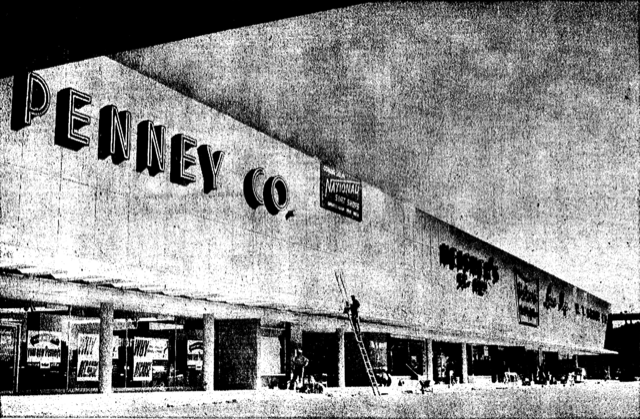
Biscayne Shopping Center, 1955
With 1,700 parking spaces, 38 retail stores, and a 400-seat restaurant, Biscayne Shopping Center holds the distinction of being among Miami's first shopping malls. Built in 1955, this proto-MiMo complex consisted of three buildings connected by overhanging bridges. It represented the booming concentration of residences and spending capital north of the city's center, far from the traffic-clogged streets of downtown. It's also noteworthy that it was the location of the first J.C. Penney in Miami.
A year before its opening, a building permit for a $2.4 million structure had been issued by the Miami Building Department to the Sommer Brothers Construction Company. The Sommers — Sigmund and Irving — had extensive real-estate holdings in New York. Their investment revealed the area's perceived financial potential.
Few things excited white, middle-class Americans more than amenities for their shiny cars.
tweet this
The local architecture firm Robert Fitch Smith was tapped to design Biscayne Shopping Center, which was built with precast concrete. It was designed with overhanging roofs, balconies, and marquees that protected shoppers from the rain and heat. The astute use of color used varying shades of beige and muted tropical tones representative of the sea. Perhaps most impressive to shoppers was the size of the parking lot. Suburbanites were finally living the motorized existence that had been predicted for American society since the '20s. Few things excited white, middle-class Americans more than amenities for their shiny cars.
An advertisement announcing the mall's grand opening boasted, "For the first time, Greater Miami has an opportunity to shop in an uncongested, spacious plaza — with the big plus of downtown selection and service. All stores in this huge shopping plaza are complete merchandising operations." The grand-opening "gala" would include "festivities to lure the masses." There was even a raffle whose grand prize was a 1955 Chevrolet.
Over the years, the shopping center's name has changed. Today it's known as Midpoint.
163rd Street Shopping Center, 1956
The 163rd Street Shopping Center was the first major example of an architecturally modern shopping center in Dade County. The massive, 50-acre complex housed 49 inward-facing storefronts. It was designed to emulate the feeling of a downtown shopping district, with stores to the left and right of the main passage. Marketed as being "just like three blocks out of Flagler Street," the North Miami Beach mall could accommodate a whopping 4,000 cars; it included more than twice the number of parking spots as Biscayne Shopping Center. The cost was $15 million, and the project was spearheaded by the president of Food Fair, a now-defunct South Florida grocery store.
The 163rd Street Shopping Center marked an evolution in the Miami mall because it included two major department stores that were direct competitors bookending the complex. Though seemingly counterintuitive, this practice had become increasingly popular in other parts of the United States. Pinning Miami department-store meccas Burdines and Richard's at opposite ends of the mall sustained the smaller retailers in between. And by all contemporary accounts, there was enough projected wealth in the area for all merchandisers. An estimated 400,000 people lived within ten miles of the new center.
It marked an evolution because it included two major department stores that were direct competitors.
tweet this
Florida's indoor-outdoor lifestyle was the architectural theme behind the center's design. A roofless, 2,000-foot open space was at the center; there were almost 50 stores on both sides. Retailers on opening day included Burdines, Walgreens, J.C. Penney, and Food Fair. Unlike today, it was commonplace and considered good practice for shopping malls to include grocery stores.
The story of the architecture firm that designed the 163rd Street Shopping Center — Gamble, Pownall & Gilroy — parallels the post-World War II boom on Florida's Gold Coast. The three partners met as officers in the Navy's Civil Engineer Corps and established a partnership in South Florida after discharge from the service. When the mall in North Miami Beach was being designed, their firm included more than 40 partners and had probably designed more shopping centers than any other in Florida.
It's revealing that after the acreage for the mall was purchased, other developers began buying up the land around it and advertising their homes as convenient to shopping. The thousands of shoppers who were predicted to patronize the center were expected to attract even more businesses. In turn, there would be more schools and infrastructure.
The mall was later enclosed and air-conditioned. Today's version, known as the Mall at 163rd Street, bears little resemblance to the architectural gem that was completed more than 60 years ago.
Northside Shopping Centre, 1960
The architectural themes and layout found in the 163rd Street Shopping Center largely influenced the birth of Northside Shopping Center, which included a large open-air corridor with tropical landscaping. Northside, on NW 27th Avenue at NW 79th Street, represented a realization by commercial capitalists that these monolithic structures could find a home in well-established communities as well as new and upcoming neighborhoods.
Northside offered the largest Sears in the Southeast.
tweet this
The mall was developed by Sears, the Allen Morris Company, and Arthur Vining Davis, who would later develop Dadeland Mall. The $15 million facility included 491,200 square feet and 48 stores. The official grand opening was held March 16, 1960, and was attended by thousands.
Northside offered the largest Sears in the Southeast. In a small instance of foreshadowing, the mall was decorated with lush tropical foliage and several terrazzo animal statues similar to those that Davis would execute on a much larger scale in Dadeland three years later. It was almost as if Northside was a practice round for him. The shopping complex served as a commercial center for residents of Hialeah and the African-American community around it.
Today, Northside is best known for its indoor flea market.
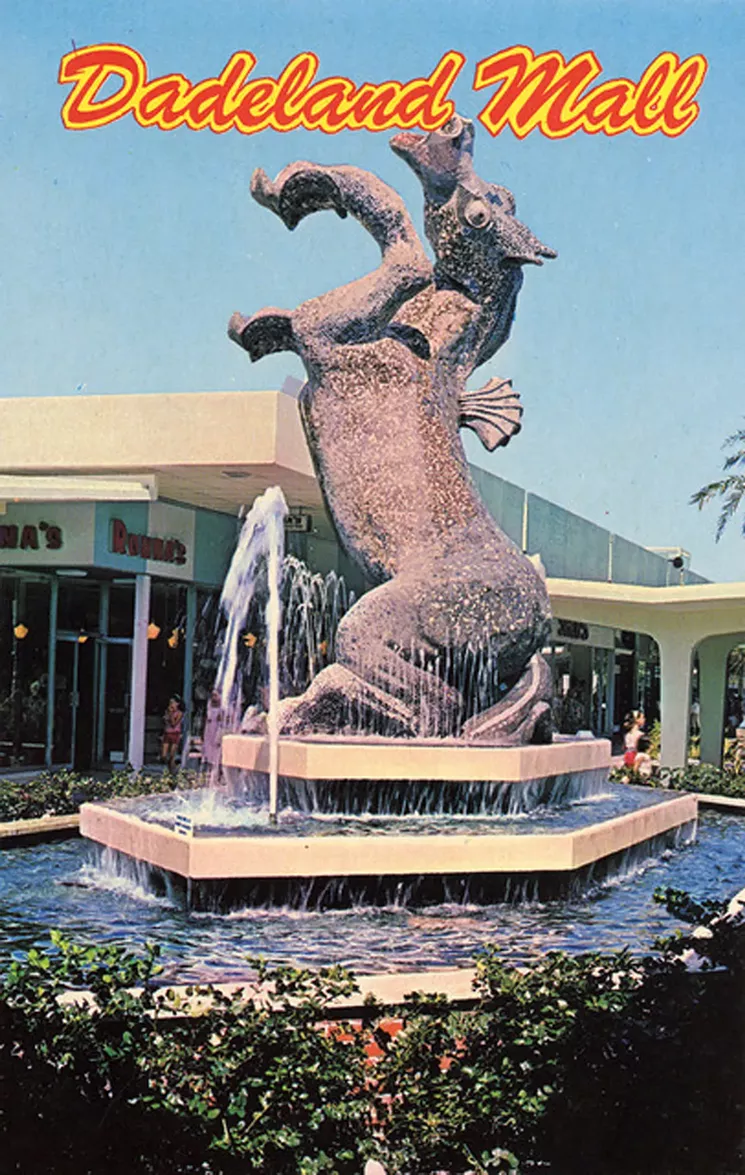
Dadeland Mall, 1962
Dadeland Mall opened in January 1962. It was part of an initiative undertaken by Arthur Vining Davis, who in 1957 was the largest individual landholder in Dade County. When construction began in 1961, it was projected to open around the same time the 25-mile Palmetto Expressway would be completed. This was no coincidence, for Davis understood that highways carried both cars and customers. The mall's location was described in a 1961 Miami News article as a "delta at the mouth of two great rivers" because of its placement between South Dixie Highway and the newly constructed Palmetto Bypass junction at North Kendall Drive.
The new mall stood on more than 70 acres and housed 63 stores, dwarfing the 50-acre 163rd Street Shopping Center. Situated 20 miles south of downtown Miami, Dadeland Mall was a symbol of the growing residential population in South Dade in the '60s. Within a five-mile radius, combined income was more than $400 million, according to the Miami News. That was more than twice the amount surrounding the 163rd Street Shopping Center.
The mall's designer, the architecture firm Weed-Johnson Associates, was inspired by British West Indies-style homes found in Key West. Construction was carried out by Frank J. Rooney General Contractors, which had also built the 163rd Street Shopping Center and the Northside Shopping Center. Today's Dadeland Mall bears little resemblance to the one of 1962. It was originally an open-air shopping center populated by mosaic statues. The most famous of them was a stylized portrayal of a seahorse that graced the mall's main entrance. In fact, Dadeland Mall used to play a much larger role in the arts. Like other shopping centers, it hosted art exhibitions and performances that were free and open to the public.
Dadeland Mall was perhaps the most successful in transforming with the changing times. It has seen countless instances of expansion, remodeling, and renovation. The complex has grown to become one of the most lucrative malls in the United States and still stands as an economic force.
Bal Harbour Shops, 1966
When Bal Harbour Shops opened in 1965 on the site of a former World War II German POW camp, it marked a giant step in the evolution of the Miami mall. Until then, every shopping center had so-called essential service tenants that ranged from grocery stores to locksmiths. The typical shopping centers — even the poshest ones then in existence — relied on standards such as the supermarket, dry cleaner, shoemaker, and furniture store for basic revenue. Without that kind of retail outlet, it was believed a shopping plaza stood little chance of success. Bal Harbour Shops was the first in Miami to refuse to rent storefronts to any of those businesses.
There was doubt that a mall without a supermarket could sustain itself.
tweet this
Developer Stanley F. Whitman, whose family had lived in the area for three generations, intended Bal Harbour Shops to be Florida's first exclusive, high-fashion shopping destination. Though Whitman saw the area's potential, everyone else wasn't so sure. There was doubt that a mall without a supermarket could sustain itself. In fact, when construction on the mall began, none of the retail storefronts had been rented. But Whitman had confidence in the project's viability. With the last-minute announcement that Neiman Marcus would be the mall's anchor tenant, the rest of the storefronts quickly followed.
When it opened, Bal Harbour Shops was surrounded by 2,500 hotel rooms, expensive homes, and luxury apartments. Whitman was quoted as saying, "It'll go because the Gold Coast has become a year-round resort where the wealthy tourist is the cake and the wealthy South Florida resident is the icing." He wasn't wrong. Bal Harbour Shops' strategic placement and carefully curated retailers proved to be immensely successful from the get-go and remain that way.
Omni International Mall, 1977
Omni International Mall opened in 1977 on the site of an old Jordan Marsh department store off Biscayne Boulevard. The Omni represented a returned faith in Miami's downtown as a viable financial center of commerce. The development became a beacon for other multimillion-dollar developments. It was one of the few malls built amid patterned gentrification rather than on undeveloped farmland. Dozens of homes were demolished, although one stubborn owner refused to sell, resulting in a largely comedic scenario in which a small home was situated feet from a massive urban shopping complex. It's also worth noting the Omni was among the first fully enclosed malls in the area.
The project was unlike anything Miami had seen. It housed a hotel and a multiplex movie theater. Perhaps most fondly remembered was the large children's carousel. As the '80s dawned, shopping centers enjoyed a heyday throughout the decade. Wealthy Latin American tourists cycled in and out of the hotel attached to the Omni.
Perhaps most fondly remembered at the Omni was the large children's carousel.
tweet this
Eventually, the mall suffered several years of waning sales before the company that operated it went out of business by 2000.
The Omni is also worth mentioning because the structure was successfully repurposed for a university and businesses. It's largely accepted that repurposing older buildings is more environmentally friendly than demolishing and rebuilding, because the amount of fuel burned in demolition is staggering, plus new structures require more building materials.
Aventura Mall, 1983
Ah, the '80s. Aventura Mall, essentially a small city of commerce, opened in April 1983. It stands today as the second largest shopping mall in the nation (behind Mall of America in Minnesota) and the largest in Florida, not including outlets. It includes a whopping five department stores, 300 retailers, 50 eateries, an AMC Theatres cineplex, a 93-foot-tall slide tower, and more than 20 museum-quality works of art. Nothing in Dade County had ever been so large, and nothing larger has been built since.
Aventura Mall measured more than 1.2 million square feet when it was first built, and it has since doubled in size. It currently offers 9,800 parking spaces and three levels of shopping. It holds the distinction of hosting the first Macy's in Dade County.
It's no secret the American mall is hurting. Countless shopping centers across the nation have been shuttered and abandoned, their remains left to weather. Online business, meanwhile, is booming. In fact, it could be argued the smart phone has replaced the need for the American shopping center. No, it's not exactly the same, but's it's not entirely different either.
Nothing in Dade County had ever been so large, and nothing larger has been built since.
tweet this
More than a few questions are left to be answered. What will we do with these giant commercial structures? In 2014, 777 International Mall on downtown Miami's Flagler Street was purchased by billionaire businessman Moishe Mana and is currently being used as artist studios. Perhaps the arts will play a large role in repurposing and rebirthing these colossal structures. As of now, it's too soon to say for sure.
Another question: Are we simply on the cusp of a change in the role that malls will play for future generations? After the birth of Aventura Mall in the '80s, there was little development in the shopping mall as a concept. But then America's largest shopping center was proposed to be built in Northwest Miami-Dade. Ominously and unapologetically named American Dream Miami, it's planned to include 2,200 hotel rooms, an amusement park, a Ferris wheel, an ice rink, an indoor ski slope, a sea lion park, and an artificial lake for submarine rides.
If it's ever built, it will be like Disney World without the branding. The total retail area is projected to measure more than 6 million square feet. The viability of the project seems to be picking up traction despite pushback from naturalists who argue the complex would harm the nearby Everglades National Park.
Is the megamall a metaphor for the American dream? As we march into the digital age, abandoned structures are often left to decay as halls silently echo the sounds of yesteryear's crowds. If the American dream ever lived inside a Miami shopping mall, it seems as if it packed its wares, closed up shop, and left to pursue profits elsewhere. What remains is something entirely different.

